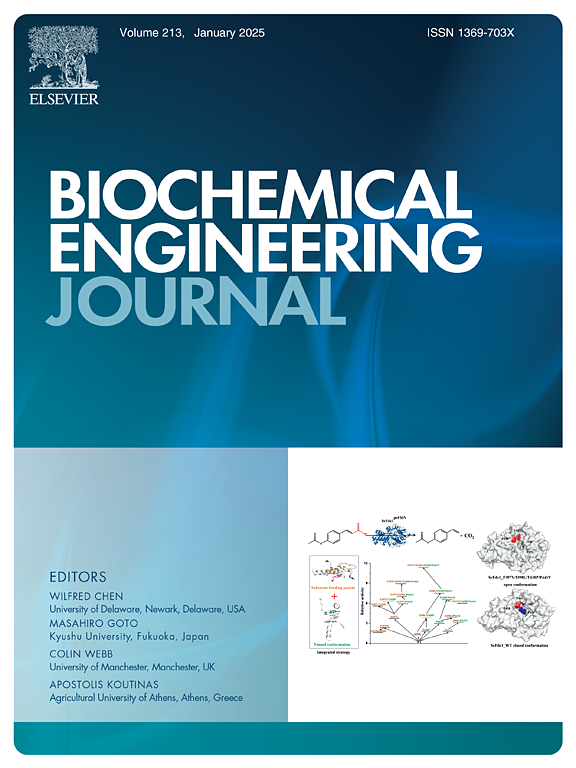Voltage application and biomass retention increased biogas production in a combined microbial electrolysis cell and anaerobic digestion system treating chicken manure
IF 3.7
3区 生物学
Q2 BIOTECHNOLOGY & APPLIED MICROBIOLOGY
引用次数: 0
Abstract
This study investigates the effect of the voltage application and biomass retention on the biogas production performance of a combined microbial electrolysis cell and anaerobic digestion (MEC+AD) reactor operated at different organic loading rates (OLR). The chicken manure (CM) with a content of 6 % VS was fed to the reactors as substrate at various hydraulic retention times (HRT) ranging from 3 to 20 days. It was observed that the conventional anaerobic digestion (AD) reactor collapsed due to the overloading at the HRT of 5 days. On the other hand, due to the voltage application and biomass retention on the electrodes of the combined reactors, (MEC+AD)C without a voltage application and (MEC+AD)0.3 with a voltage application of 0.3 V presented the highest methane production of 1.98 ± 0.19 and 2.37 ± 0.32 L/LR/d, respectively. Organic removal rates of the combined reactors were similar to each other; however, in terms of biogas production, (MEC+AD)0.3 presented superior performance at all sets due to the voltage application and microbial community on the electrodes. Methanosarcina had a dominance of 5 % at the cathode of (MEC+AD)0.3 at the genus level, which affected the results. The highest methane yield obtained in this study was 373 ± 72 mL CH4/g VS at (MEC+AD)0.3, which was 30 % higher than that of (MEC+AD)C due to the voltage application and the genus Methanosarcina on the cathode.
在处理鸡粪的组合微生物电解池和厌氧消化系统中,施加电压和生物量保留增加了沼气产量
本研究研究了电压施加和生物量保留对不同有机负荷率(OLR)下微生物电解池和厌氧消化(MEC+AD)组合反应器产气性能的影响。将含有6 % VS的鸡粪(CM)作为底物,在3 ~ 20天的不同水力停留时间(HRT)下投喂到反应器中。结果表明,常规厌氧消化(AD)反应器在HRT为5 d时因超载而坍塌。另一方面,由于电压施加和生物质滞留,(MEC+AD)C不施加电压和(MEC+AD)0.3施加电压为0.3 V时的甲烷产量最高,分别为1.98 ± 0.19和2.37 ± 0.32 L/LR/d。组合反应器的有机物去除率基本一致;然而,就沼气产量而言,(MEC+AD)0.3在所有设置下都表现出优异的性能,这是由于电压施加和电极上的微生物群落。在属水平上,Methanosarcina在(MEC+AD)0.3的阴极上具有5 %的优势,影响了结果。在(MEC+AD)0.3条件下,甲烷产率最高为373 ± 72 mL CH4/g VS,比(MEC+AD)C条件下的甲烷产率高30 %。
本文章由计算机程序翻译,如有差异,请以英文原文为准。
求助全文
约1分钟内获得全文
求助全文
来源期刊

Biochemical Engineering Journal
工程技术-工程:化工
CiteScore
7.10
自引率
5.10%
发文量
380
审稿时长
34 days
期刊介绍:
The Biochemical Engineering Journal aims to promote progress in the crucial chemical engineering aspects of the development of biological processes associated with everything from raw materials preparation to product recovery relevant to industries as diverse as medical/healthcare, industrial biotechnology, and environmental biotechnology.
The Journal welcomes full length original research papers, short communications, and review papers* in the following research fields:
Biocatalysis (enzyme or microbial) and biotransformations, including immobilized biocatalyst preparation and kinetics
Biosensors and Biodevices including biofabrication and novel fuel cell development
Bioseparations including scale-up and protein refolding/renaturation
Environmental Bioengineering including bioconversion, bioremediation, and microbial fuel cells
Bioreactor Systems including characterization, optimization and scale-up
Bioresources and Biorefinery Engineering including biomass conversion, biofuels, bioenergy, and optimization
Industrial Biotechnology including specialty chemicals, platform chemicals and neutraceuticals
Biomaterials and Tissue Engineering including bioartificial organs, cell encapsulation, and controlled release
Cell Culture Engineering (plant, animal or insect cells) including viral vectors, monoclonal antibodies, recombinant proteins, vaccines, and secondary metabolites
Cell Therapies and Stem Cells including pluripotent, mesenchymal and hematopoietic stem cells; immunotherapies; tissue-specific differentiation; and cryopreservation
Metabolic Engineering, Systems and Synthetic Biology including OMICS, bioinformatics, in silico biology, and metabolic flux analysis
Protein Engineering including enzyme engineering and directed evolution.
 求助内容:
求助内容: 应助结果提醒方式:
应助结果提醒方式:


